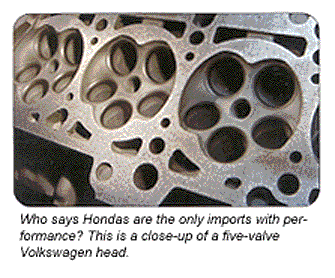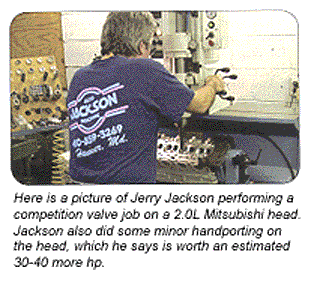The most popular nameplates are imports such as Honda, Acura and Mitsubishi, but coming on fast are Nissan, Toyota, Mazda, Subaru and Volkswagen – plus domestic models such as Ford Focus, Dodge Neon and even Chevy Cavalier.
Nobody is abandoning the small block Chevy or any of the other V8s that have traditionally been the mainstay of the performance aftermarket. But in a highly competitive market, there’s always pressure to grow your customer base and to find new opportunities. One such opportunity is doing performance work on sport compact car engines.
The market for this kind of work is not just a west coast phenomenon. It’s nationwide and growing every day. The typical prospect for performance work is an 18 to 28 year old male who owns a four to 10 year old sport compact car. He’s already spent several thousand dollars on trick accessories such as flashy wheels, ultra low profile tires, cross-drilled brake rotors, coil over struts, spoilers and wings. Now he’s ready for some serious power upgrades. He may have already done some bolt-ons such as a bigger throttle body, cold air intake system, exhaust headers and megaphone muffler. Maybe he’s even added a bottle of nitrous oxide. Bolt-ons are great but if the guy wants a killer street motor or an all-out race car, he’s going to have to put some significant money in the engine itself.
Most of these people are computer savy but are lacking in mechanical skills – and certainly don’t have the equipment or expertise to do head modifications or other internal engine work such as boring, balancing, porting and polishing, valve guide and seat installations, etc. That’s why they need the services of an experienced race shop.
Less Is More
It’s not unusual for some of these tricked-up sport compact car engines to produce 300 hp in naturally aspirated form, and well over 450 hp with a turbocharger or supercharger. That’s a lot of power from engines that typically produce around 160 hp in stock form. The secret to getting these kind of numbers is maximizing airflow and compression. Reworking the cylinder heads to flow more air, which typically involves porting the heads, installing oversized valves, massaging the bowls and combustion chambers, and increasing valve lift and duration are all traditional hot rodding tricks that work just as well on sport compact engines as they do on a traditional V8.
To find out how some shops are reworking these little motors, we interviewed a number of shops on both coasts. Some are specialists who only do certain nameplates while others do anything that comes in the door.
Mitsubishi Magic
Jerry Jackson of Jackson Auto Machine in Hanover, MD (www.jacksonautomachine.com), runs a shop that does all makes and models of engines but has developed a niche for himself by focusing on Mitsubishi.
“We got into building performance import engines about six or seven years before it became so popular. Now everybody wants to be involved with imports. But you have to be willing to make the investment in time and equipment to do the work. A lot of people don’t really understand these smaller engines and underestimate their potential. They say a four cylinder can’t make serious power. But with the right modifications, these little engines are capable of producing up to six or seven horsepower per cubic inch. Those are numbers Chevrolet engine builders would have killed for twenty years ago.”
Jackson says a modified street/strip four cylinder Mitsubishi will generally put out 350 to 450 hp at the wheels. He also said one of his all-out Mitsubishi race motors cranked out 760 hp on a dyno – without nitrous.
“We currently offer a CNC ported cylinder head for the Mitsubishi 2.0L 4G63. We start with a factory casting and take it from there. The port locations in the stock head can vary quite a bit so we CNC machine the ports to optimize airflow. Our Stage 1 version of this head sells for $2,475 and is capable of producing over 550 hp. This same head design ran 8 second times on the drag strip over three years ago. It includes our own high performance springs, titanium retainers and stainless steel valves. We use stock sized intake valves, but can go larger if needed. We also use stock valve seats but use our own custom-made bronze valve guides. The cams we use are custom ground to our specifications, and are always changing as we make new improvements. And every head is flow tested to make sure there is less than half a percent variation cylinder to cylinder.

“With our springs and retainers, the Mitsubishi heads can safely handle 8,500 to 9,000 rpm depending on the cams. The redline for the factory cams is about 7,000 to 7,200 rpm.”
Jackson said he doesn’t have heads sitting on the shelf ready to go but custom builds each one to suit the customer’s needs and application. He also offers a Stage 2 and Stage 3 version of his Mitsubishi 4G63 head. Stage 3 is an all-out racing head that is fully hand finished and polished after it has been CNC machined. The Stage 3 head goes for $3,000.
To seal the heads, Jackson uses multi-layer steel (MLS) heads gaskets he sources from Spain. He says these work well for engines up to about 450 horsepower. For the all-out race motors, he prefers to use copper head gaskets with o-rings and receiver grooves.
Smooth Sealing
MLS gaskets that are used on many Japanese engines require extremely smooth surface finishes to seal properly (20 to 30 Ra or less), which poses a real challenge for the aftermarket. Many shops do not have the proper milling equipment to reproduce such a smooth surface finish. For this reason, some say it’s better not to attempt to resurface a head on an engine with an MLS gasket unless absolutely necessary. Even so, many of the heads on these engines do need to be resurfaced by the time our readers see them. That’s why gasket manufacturers are introducing aftermarket gaskets that can tolerate a somewhat rougher surface finish. By using a thicker surface coating on the MLS gasket, the need for an ultra smooth finish is eliminated. Some of the aftermarket MLS replacement gaskets can reportedly handle a surface finish to 60 to 70 Ra, which is on par with conventional gaskets.
Aftermarket MLS gaskets have also been introduced as replacements for some engine applications that were not originally equipped with an MLS head gasket. These include the Toyota 5VZFE 3.4L V6 truck engine, and the 2.0L Dodge Neon. On both applications, an MLS replacement gasket provides a much more durable sealing solution and does not require any special surface finish.
Killer Hondas
Paulus Lee of AEBS Racing in San Diego, CA (www.aebsracing.com) specializes in sport compact engines almost exclusively, with Honda being his number one most popular engine followed by Nissan and Subaru. Lee says his AEBS Racing Heads are custom made to order, with all porting and polishing being done by hand. Each cylinder head is reworked for the type of driving or racing the customer wants to do.
Lee says three things affect how much horsepower a head will make: combustion efficiency, volumetric efficiency and thermal efficiency. Sometimes you have to trade one for another but the goal is to optimize each so the engine will make the most power possible.
“One thing we always try to do is to maintain or increase air velocity. The cubic feet per minute (cfm) capacity of a head depends on air velocity times the area of the ports. You want to keep the momentum of the incoming air high so that it will fill the cylinders more efficiently and make more power. We also like to produce swirl in the combustion chambers because this improves combustion.”
Lee says he reworks the combustion chambers on the Honda heads to create a “cloverleaf” shape that increases swirl. It’s the same design concept that is used in many Indy Racing League motors. The cloverleaf works best in naturally aspirated engines but is not needed in turbocharged engines, he says, because the air is already turbulent as it exits the turbo. For turbo motors, an unshrouded combustion chamber works best.
“Our typical customer will spend $750 up to $1,500 or more on head work. The cost depends on how much welding is required and how much work is done to the ports.”
Lee says one of the keys to making power gains in the head is the angle and radius of the valve seat. The right contour can add as much as 25 cfm to the flow capacity of the head. Lee says he’s spent over a hundred hours perfecting the optimum valve seat contour and keeps it as a closely guarded secret.
In some applications, he installs tungsten carbide seats and prefers bronze valve guides for most. He uses stainless steel valves because titanium valves are too expensive for most of his customers and aren’t really necessary in these engines. For camshafts, he uses Toda cams from Japan. He says the Toda cams may not have the hottest grinds but they are bullet-proof reliable unlike some other brands of cams he has tried in the past. For valves and springs, he uses REV products.
So how much power do some of Lee’s Honda engines make? He says a typical naturally aspirated 2.0L Honda B street engine with a 86 mm bore and stock 89 mm crank can produce 280 horsepower at the wheels (or about 329 horsepower at the crankshaft). He’s also built a turbocharged 2.2L Prelude that puts out over 1,000 horsepower at the wheels running 40 lbs. of boost pressure.
Lee says the demand for import performance work has been very strong, and should continue to expand in the years ahead. “We are currently building a 600 hp supercharged Nissan 3.5L V6 and are using it to develop future products. This engine should be very popular in the future because it is used in so many Nissan models. We have already developed a cylinder sleeve for this engine that allows us to increase the bore size from 95.5 mm up to 102 mm.”
Lee said another engine to watch is the new QR25 four cylinder that Nissan is using in the 2002 and newer Altima. It is a very strong engine with a high flow head that should easily lend itself to many performance upgrades.
More Hondas
Another west coast shop that is doing a lot of Honda work is Larry’s Performance in Montebello, CA. Jimmy Escamilla says he works on all kinds of engines, but that the Hondas are really popular. The modifications he typically does includes hand porting the heads, installing larger intake valves, welding and reworking he combustion chambers to raise compression, installing larger valve springs and installing Bronze Guide Liners













